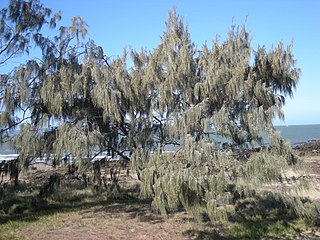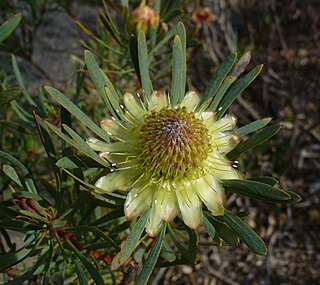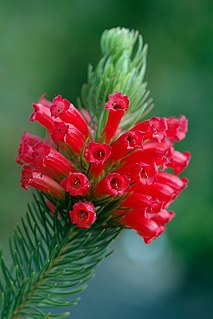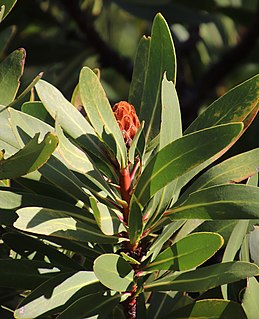
Casuarina equisetifolia, the Australian pine tree or whistling pine tree, is a she-oak species of the genus Casuarina. The native range extends throughout Southeast Asia, Northern Australia and the Pacific Islands; including Thailand, Myanmar, Vietnam, Malaysia, Singapore, Brunei, Indonesia, East Timor, and the Philippines, east to Papua New Guinea, French Polynesia, New Caledonia, and Vanuatu, and south to Australia. Populations are also found in Madagascar, but it is doubtful if this is within the native range of the species. The species has been introduced to the Southern United States and West Africa. It is an invasive species in Florida, South Africa, India and Brazil.

Kirstenbosch is an important botanical garden nestled at the eastern foot of Table Mountain in Cape Town. The garden is one of ten National Botanical Gardens covering five of South Africa's six different biomes and administered by the South African National Biodiversity Institute (SANBI). Prior to 1 September 2004, the institute was known as the National Botanical Institute.

The Department of Environment, Forestry & Fisheries is one of the departments of the South African government. It is responsible for protecting, conserving and improving the South African environment and natural resources. It was created in 2019 by the merger of the Department of Environmental Affairs with the forestry and fisheries components of the Department of Agriculture, Forestry and Fisheries.

Protea scolymocephala, also known as the thistle protea or thistle sugarbush, is a flowering plant from the genus Protea native to South Africa.
SABAP2 is the acronym for the Southern African Bird Atlas Project 2, which is the follow-up to the Southern African Bird Atlas Project. The first atlas project took place from 1987 to 1991. The current project was a joint venture between the Animal Demography Unit at the University of Cape Town, BirdLife South Africa, and the South African National Biodiversity Institute (SANBI). Following the closure of the Animal Demography Unit, the project is now managed by the FitzPatrick Institute of African Ornithology, University of Cape Town. The project aims to map the distribution and relative abundance of birds in southern Africa, and the original atlas area included South Africa, Lesotho, and Eswatini, although since 2012 the project has expanded to include Namibia, Botswana, Zimbabwe and Mozambique. SABAP2 was launched on 1 July 2007. The field work for this project is conducted by more than 1700 volunteers, known as citizen scientists – they collect the data in the field at their own cost and in their own time. As such they make a huge contribution to the conservation of birds and their habitat.

Erica abietina is a species of erica that is endemic to the Cape Peninsula of the Western Cape, South Africa. E. abietina includes four subspecies with often highly restricted distributions and distinctive flower colours. Previous delimitation of the species has included a further three subspecies which proved to be more distantly related to Cape Peninsula endemic E. abietina subspecies and are now classified under Erica grandiflora L.f. and Erica situshiemalis E.G.H.Oliv. & Pirie.

Protea acaulos, also known as the common ground sugarbush, is a flowering plant found in the southwestern Cape Region, South Africa. It is also simply known as ground protea; in the Afrikaans language it is known as an aardroos.

Marie Prins is a South African botanist.

iSpot is a website developed and hosted by the Open University with funding from the Open Air Laboratories (OPAL) network with an online community intended to connect nature enthusiasts of all levels.
The South African National Biodiversity Institute (SANBI) is an organisation established in 2004 in terms of the National Environmental Management: Biodiversity Act, No 10 of 2004, under the South African Department of Environmental Affairs, tasked with research and dissemination of information on biodiversity, and legally mandated to contribute to the management of the country’s biodiversity resources.

Mary Davidson Gunn was a South African librarian and biographer who developed and expanded the Mary Gunn Library into one of the most important resources on botany and biodiversity in Africa.
Graham Dugald Duncan(born 1959) is a South African botanist and specialist bulb horticulturalist at the Kirstenbosch National Botanical Garden, Cape Town, South Africa.

The Marine biodiversity of South Africa is the variety of living organisms that live in the seas off the coast of South Africa. It includes genetic, species and ecosystems biodiversity in a range of habitats spread over a range of ecologically varied regions, influenced by the geomorphology of the seabed and circulation of major and local water masses, which distribute both living organisms and nutrients in complex and time-variable patterns.

SeaKeys is a large collaborative marine biodiversity project funded through the Foundational Biodiversity Information Program in South Africa. The purpose of the project is to collect and distribute genetic, species and ecosystem information relating to marine biodiversity in southern Africa, which may be used to support informed decision-making about the marine environment.

Protea pendula, also known as the nodding sugarbush or arid sugarbush, is a flowering plant of the genus Protea, in the family Proteaceae, which is only found growing in the wild in the Cape Region of South Africa. In the Afrikaans language it is known as knikkopsuikerbossie or ondersteboknopprotea.
Protea vogtsiae, also known as the Kouga sugarbush, is a small flowering shrub of the genus Protea within the family Proteaceae, which is only found growing in the wild in the southern Cape Region of South Africa.

Protea rubropilosa, also known as the Transvaal sugarbush, escarpment sugarbush or Transvaal mountain sugarbush, is a flowering tree, that belongs to the genus Protea in the family Proteaceae. The plant only occurs in South Africa.
Protea convexa, also known as large-leaf sugarbush, is a rare flowering shrub in the genus Protea of the family Proteaceae, which is endemic to the southwestern Cape Region of South Africa.
The Biodiversity of South Africa is the variety of living organisms within the boundaries of South Africa and its exclusive economic zone. South Africa is a region of high biodiversity in the terrestrial and marine realms. The country is ranked sixth out of the world's seventeen megadiverse countries, and is rated among the top 10 for plant species diversity and third for marine endemism.

Brian John Huntley is a retired professor and conservation scientist from South Africa who helped to develop and transform African national parks. He played a big role in expanding the National Botanical Institute to become an authoritative repository on South African flora and fauna. As an independent expert, he was a consultant for agencies and international organizations, including the United Nations, with regard to nature conservation. He himself took part in multiple conservation projects around Africa.














